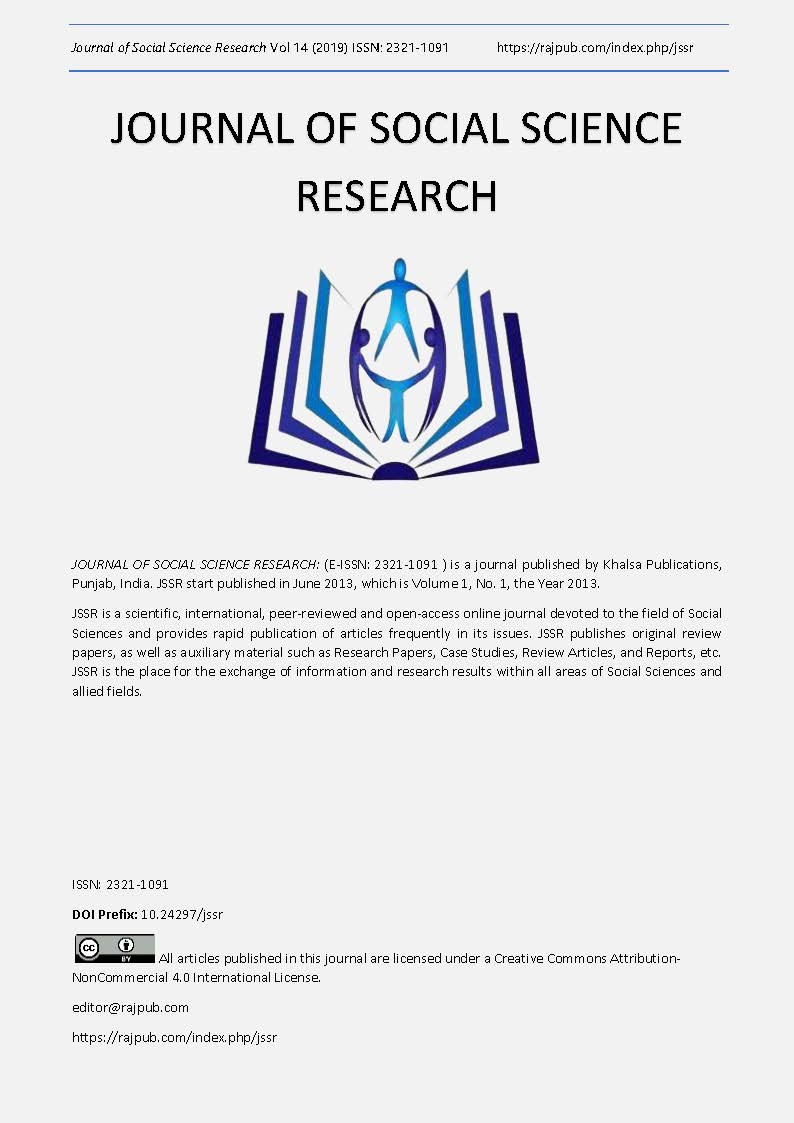A Conflict Profile On The Rohingya Conflict in Myanmar
DOI:
https://doi.org/10.24297/jssr.v14i0.8407Abstract
‘Rohingya’- world’s most persecuted minority group came to the attention of the international media again in the mid of 2017 due to the brutality they were experiencing in their homeland by the state authority of Myanmar. Now they are being labeled as the ‘perpetual other’ of Myanmar and as the ‘Bengali intruders’ by the society regardless of being the inhabitants in the Rakhine state for centuries (The Diplomat 2017). As a result of this Bangladesh experienced the largest surge of displaced people into its border after its independence. They are ‘culturally discriminated, economically exploited and politically sidelined’ and are being discerned by the Arakan people as a threat to their national identity and an additional competitor for the natural resources (Wolf 2015). It is widely believed that the reason of the violent crackdown of the military against the ‘Rohingya’ community in the Arakan state is either religiously or ethnically motivated. But this is only a splinter part of the entire truth. These violent atrocities against the Rohingya community is more politically and economically motivated than religiously and ethnically. This paper will focus on the causes of the present crisis which started to unveil since 2017 and how these are linked with the interest of the different stakeholders like: the Military junta of Myanmar, Arakan Rohingya Salvation Army (ARSA), ASEAN, Bangladesh, Indian government, China, the UN, etc. To understand the causes and the effects of the conflict this paper will use the tool of ‘conflict tree’ and the ‘conflict onion’ will be used as a tool to understand the positions, needs and interests of different actors.
Downloads
References
ICG. 2016. “Myanmar: A New Muslim Insurgency in Rakhine State | Crisis Group.” International Crisis Group. 2016. https://www.crisisgroup.org/asia/south-east-asia/myanmar/283-myanmar-new-muslim-insurgency-rakhine-state.
Joy, Adrienne. 2018. “Understanding China’s Response to the Rakhine Crisis.” Washington. www.usip.org.
Lee, Hui Ying. 2018. “ASEAN’s Limited Role in Solving the Rohingya Crisis | The Diplomat.” The Diplomat. 2018. https://thediplomat.com/2018/10/aseans-limited-role-in-solving-the-rohingya-crisis/.
Mirante, Edith. 2016. “Between China and Myanmar: The Battleground Region of Northeastern Myanmar Faces an Uncertain Future | The Diplomat.” The Diplomat. 2016. https://thediplomat.com/2016/03/between-china-and-myanmar-the-battleground-region-of-northeastern-myanmar-faces-an-uncertain-future/.
Paul, Ruma. 2018. “Bangladesh, Myanmar Agree to Begin Rohingya Repatriation by Mid-November - Reuters.” Reuters. 2018. https://www.reuters.com/article/us-myanmar-rohingya/bangladesh-myanmar-agree-to-begin-rohingya-repatriation-by-mid-november-idUSKCN1N414Q.
Persio, Sofia Lotto. 2017. “Why Myanmar Hates the Rohingya.” Newsweek. 2017. https://www.newsweek.com/why-myanmar-hates-rohingya-665883.
Petersen, Hannah Ellis, and Sheikh Azizur Rahman. 2018. “UN Criticises Rohingya Deal between Myanmar and Bangladesh | World News | The Guardian.” The Guardian. 2018. https://www.theguardian.com/world/2018/oct/31/un-criticises-rohingya-deal-between-myanmar-and-bangladesh.
Reliefweb. 2018. “Asia Refugee Policy Analysis - Bangladesh | ReliefWeb.” The Reliefweb. 2018. https://reliefweb.int/report/bangladesh/asia-refugee-policy-analysis.
Sassen, Saskia. 2017. “Is Rohingya Persecution Caused by Business Interests Rather than Religion? | Working in Development | The Guardian.” The Guardian. 2017. https://www.theguardian.com/global-development-professionals-network/2017/jan/04/is-rohingya-persecution-caused-by-business-interests-rather-than-religion.
Shivakoti, Richa. 2017. “ASEAN’s Role in the Rohingya Refugee Crisis | Forced Migration Review.” Forced Migration Review. 2017. https://www.fmreview.org/latinamerica-caribbean/shivakoti.
The Diplomat. 2017. “Why ASEAN Can’t Ignore the Rohingya Crisis | The Diplomat.” The Diplomat. 2017. https://thediplomat.com/2017/05/why-asean-cant-ignore-the-rohingya-crisis/.
The Guardian. 2016. “Malaysia PM Urges World to Act against ‘genocide’ of Myanmar’s Rohingya | World News | The Guardian.” The Guardian. 2016. https://www.theguardian.com/world/2016/dec/04/malaysia-pm-urges-world-to-act-against-genocide-of-myanmars-rohingya.
———. 2018. “Myanmar’s Military Must Be Prosecuted for Rohingya ‘Ethnic Cleansing’, UN Told | World News | The Guardian.” The Guardian. 2018. https://www.theguardian.com/world/2018/aug/29/myanmars-military-must-be-prosecuted-for-rohingya-ethnic-cleansing-un-told.
The Hindu. 2018. “India Starts Construction of ?1,600-Cr Mizoram-Myanmar Kaladan Road - The Hindu BusinessLine.” The Hindu Business Line. 2018. https://www.thehindubusinessline.com/news/india-starts-construction-of-1600-cr-mizoram-myanmar-kaladan-road/article23577107.ece.
The Straits Times. 2019. “Outcry as Asean Report Predicts ‘smooth’ Return of Rohingya to Myanmar, SE Asia News & Top Stories - The Straits Times.” The Straits Times. 2019. https://www.straitstimes.com/asia/se-asia/outcry-as-an-asean-report-predicts-smooth-return-of-rohingya-to-myanmar.
Wolf, Siegfried O. 2015. “Myanmar?s Rohingya Conflict ?more Economic than Religious? | Asia| An In-Depth Look at News from across the Continent | DW | 04.06.2015.” Www.Dw.Com. 2015. https://www.dw.com/en/myanmars-rohingya-conflict-more-economic-than-religious/a-18496206.
Yhome, K. 2018. “Examining India’s Stance on the Rohingya Crisis.” India. https://www.orfonline.org/wp-content/uploads/2018/07/ORF_IssueBrief_247_Rohingya_FinalForUpload.pdf.
Downloads
Published
How to Cite
Issue
Section
License
 All articles published in Journal of Advances in Linguistics are licensed under a Creative Commons Attribution 4.0 International License.
All articles published in Journal of Advances in Linguistics are licensed under a Creative Commons Attribution 4.0 International License.




